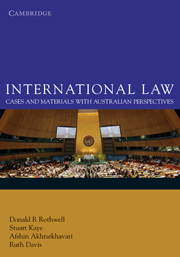Book contents
- Frontmatter
- Contents
- Preface
- About the authors
- Acknowledgements
- Table of cases
- Table of statutes
- Table of treaties and other international instruments
- Abbreviations
- 1 The nature of international law
- 2 Sources of international law
- 3 Law of treaties
- 4 International and municipal law
- 5 International legal personality
- 6 Sovereignty over territory
- 7 Jurisdiction
- 8 State responsibility
- 9 Human rights
- 10 Law of the sea
- 11 International environmental law
- 12 Enforcement of international law
- 13 The peaceful settlement of international disputes
- Index
- References
6 - Sovereignty over territory
- Frontmatter
- Contents
- Preface
- About the authors
- Acknowledgements
- Table of cases
- Table of statutes
- Table of treaties and other international instruments
- Abbreviations
- 1 The nature of international law
- 2 Sources of international law
- 3 Law of treaties
- 4 International and municipal law
- 5 International legal personality
- 6 Sovereignty over territory
- 7 Jurisdiction
- 8 State responsibility
- 9 Human rights
- 10 Law of the sea
- 11 International environmental law
- 12 Enforcement of international law
- 13 The peaceful settlement of international disputes
- Index
- References
Summary
Introduction
The idea of sovereignty over territory is fundamental to international law. No State can exist without land, and thus the ways in which land can be acquired and retained are concerns of great importance for States. Many international disputes involve land, and are intrinsically bound up with land, and relative to the use of land, so as an issue, sovereignty sits at the heart of international relations as well as international law.
All States possess territory, so for a State to exist it will need some land. No State has no land – although there are examples of ‘micro-States’, such as the Holy See, which have extremely small areas. One body that claims statehood, but no longer possesses territory, is the Sovereign Military Hospitaller Order of St John of Jerusalem of Rhodes and of Malta, better known as the Sovereign Order of Malta. The Order was expelled from its last remaining territory on the island of Malta in 1798. Since then it has occupied certain premises in Rome which possess extraterritorial status under international law. Few States recognise the Order, so it is at best a dubious example of a State with no territory.
Title to territory is based on sovereignty, so it is necessary to indicate exactly what sovereignty will encompass. A good starting point is the judgment of Max Huber in the Island of Palmas Case:
Sovereignty in the relation between States signifies independence. Independence in regard to portion of the globe is their right to exercise therein, to the exclusion of any other State, the functions of a State.
- Type
- Chapter
- Information
- International LawCases and Materials with Australian Perspectives, pp. 265 - 293Publisher: Cambridge University PressPrint publication year: 2010



